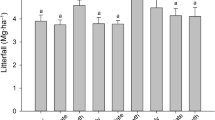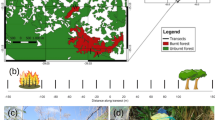Abstract
-
• The objectives of this study were to measure litterfall production of the four floodplain forest types and to analyze the relationship between litterfall (forest type, dominant species, and organic fractions) and flood pulses.
-
• Litterfall production was measured in two mono-specific stands of Salix humboldtiana or Tessaria integrifolia, respectively, and two mixed forests dominated by A. inundata or Nectandra angustifolia, during 1998 and the 2000–2002 periods.
-
• Mono-specific stands presented similar productivities (6.8 and 6.5 Mg dry matter ha−1 y−1, respectively), but differed significantly from the two other. The highest litterfall production was obtained during the large flood that occurred during 1998, decreasing later throughout the study period. Leaves were the dominant fraction of litterfall, followed by branches, flowers, and fruits.
-
• Only S. humboldtiana, T. integrifolia and A. inundata forests showed distinct patterns of litterfall production, depending on the flooding pulse. N. angustifolia did not show a distinctive litterfall pattern.
-
• The forests studied here presented patterns of litter production associated with the flood pulse according to its location along a topographic gradient, that controls the litter productivity of these forests.
Résumé
-
• Cette étude avait pour but de mesurer la production de litière dans quatre forêts alluviales et d’analyser les relations entre les litières (selon le type de forêt, l’espèce dominante, et des fractions organiques) et les crues du fleuve Paraná (Argentine).
-
• La production de litière a été mesurée dans deux forêts monospécifiques de Salix humboldtiana ou de Tessaria integrifolia, et dans deux forêts mixtes où l’espèce prédominante était soit Albizia inundata soit Nectandra angustifolia. Cette étude a été menée en 1998 puis de 2000 à 2002.
-
• Les forêts monospécifiques présentent des productions de litières similaires (6.8 et 6.5 Mg matière sèche ha−1 ans−1 respectivement) et étaient significativement différentes des deux forêts mixtes. La plus forte production de litière a été obtenue au cours de la grande crue de 1998, puis a diminué progressivement au cours du temps. Les feuilles représentaient la principale fraction des litières, tandis que les branches, les fleurs et les fruits constituent des fractions mineures.
-
• Les forêts dominées par S. humboldtiana, T. integrifolia et A. inundata ont vu leur production de litière évoluer en fonction des crues du fleuve Parana. Ce type de relation entre crue et production de litière n’a pas été détecté dans le cas des forêts de N. angustifolia.
-
• Il existe ainsi une relation entre la production de litière et la hauteur des crues, elle-même conditionnée par un gradient topographique, qui détermine donc la production de litière de ces forêts.
Similar content being viewed by others
References
Aceñolaza P., Sione W., Kalesnik F., and Serafíni M.C., 2005. Determinación de unidades homogéneas de vegetación en el Parque Nacional Pre-Delta (Argentina). Serie Misc. INSUGEO 14: 81–90.
Aceñolaza P.G., Zamboni L.P., and Gallardo J.F., 2006. Ciclos biogeoquímicos de bosques de la llanura de inundación del río Paraná (Argentina): Aporte de hojarasca. In: Gallardo Lancho J.F. (Ed.), Medioambiente en Iberoamérica: Visión desde la física y la química en los albores del SXXI, Sociedad Iberoamericana de Física y Química Ambiental, Badajoz, España, vol. 2, pp. 529–536.
Aceñolaza P., Zamboni L.P., Sione W., and Kalesnik F., 2008. Caracterización de la región superior del Complejo litoral del Río Paraná: Grandes Unidades de ambiente. Serie Misc. INSUGEO 17: 293–309.
Bray J. and Gorham E., 1964. Litter production in forest of the world. Adv. Ecol. Res. 2: 101–157.
Brinson M.M., 1990. Riverine forests. In: Lugo A.E., Brinson M.M., and Brown S. (Eds.), Forest wetlands, Elsevier, Amsterdam, pp. 87–141.
Brinson M.M., Bradshaw H.D., Holmes R.N., and Elkins J., 1980. Litterfall, stemflow and throughfall nutrient fluxes in an alluvial swamp forest. Ecology. 61: 827–835.
Carnevale N. and Lewis, J.P., 2001. Litterfall and organic matter decomposition in a seasonal forest of the eastern Chaco (Argentina). Rev. Biol. Trop. 49: 203–212.
Casco S., Neiff M., and Neiff J.J., 2005. Biodiversidad en ríos del litoral fluvial. Utilidad del software PULSO. Serie Misc. INSUGEO 14: 105–119.
Clarke P.J. and Allaway W.G., 1996. Litterfall in Casuarina glauca Coastal Wetland Forest. Aust. J. Bot. 44: 373–380.
Eglin T., Walter C., Nys C., Follain S., Forgeard F., Legout A., and Squividant H., 2008. Influence of waterlogging on carbon stock variability at hillslope scale in a beech forest (Fougères forest, West France). Ann. For. Sci. 65: 202.
Gallardo J.F., Martín A., and Santa Regina I., 1998. Nutrient cycling in deciduous forest ecosystems of the “Sierra de Gata” mountains: Nutrient supplies to the soil through both litter and throughfall. Ann. For. Sci. 55: 771–784.
Gallardo J.F., Santa Regina I., and San Miguel C., 1989. Ciclos biogeoquímicos en bosques de la Sierra de Béjar (Salamanca, España). 1. Producción de hojarasca. Rev. Ecol. Biol. Sol. 26: 35–46.
Gauch H.G., 1982. Sampling methods. In: Multivariable analysis in community ecology, Cambridge Univ. Press, Cambridge, pp. 43–63.
Godoy J.R., Petts G., and Salo J., 1999. Riparian flooded forest of the Orinoco and Amazon basins: a comparative review. Biodivers. Conserv. 8: 551–586.
Grigg A.H. and Mulligan D.R., 1999. Short note: Litterfall from two eucalypt woodlands in central Queensland. Aust. J. Ecol. 24: 662–664.
Haase R., 1999. Litterfall and nutrient return in seasonally flooded and non-flooded forest of the Pantanal, Mato Grosso, Brazil. For. Ecol. Manage. 117: 129–147.
InfoStat., 2002. InfoStat versión 1.1. Grupo InfoStat, F.C.A., Universidad Nacional de Córdoba, Argentina.
Jozami J.M. and Muñoz J.D.D., 1984. Árboles y arbustos indígenas de la provincia de Entre Ríos. I.P.N.A.P.S., CONICET-U.N.L., Santa Fé, Argentina, 85 p.
Junk W., Bayley P., and Sparks R., 1989. The flood pulse concept in river-floodplain systems. Can. Spec. Publ. Fish. Aquat. Sci. 106: 110–127.
Marchetti Z. and Aceñolaza P.G., 2005. Detección satelital y descripción de patrones de vegetación en islas del Paraná Medio. Serie Misc. INSUGEO 14: 191–197.
Martín A., Santa Regina I., and Gallardo J.F., 1994. Ciclos biogeoquímicos en un bosque perenne de encina (Quercus rotundifolia) en las proximidades de Salamanca (España): Retorno potencial. In: Gallardo J.F. (Ed.), Biogeoquímica de ecosistemas, Junta de Castilla y León, Valladolid, España, pp. 151–160.
Monedero C. and González V., 1995. Producción de hojarasca y descomposición en una selva nublada del ramal interior de la cordillera de la costa, Venezuela. Ecotrópicos. 8: 1–14.
Neiff J.J. and Poi de Neiff A., 1990. Litterfall, leaf decomposition and litter colonization of T. integrifolia (Compositae) in the Paraná River floodplain. Hydrobiology. 203: 45–52.
Proctor J., 1983. Tropical forest litterfall. I. Problems of data comparison. In: Sutton S.L., Whitmore T.C., and Chadwick A.C. (Eds.), Tropical rain forest: ecology and management, Blackwell Sci., Oxford, pp. 267–273.
Proctor J., 1984. Tropical forest litterfall. II. The data set. In: Chadwick A.C. and Sutton S. (Eds.), Tropical Rain-Forest: The leeds symposium, Proc. Leeds Philosophical & Literary Soc., Leeds, Gran Bretaña. pp. 83–113.
Raimundo F., Martins A., and Madeira M., 2008. Decomposition of chestnut litterfall and eight-year soil chemical changes under a notillage management system in Northern Portugal. Ann. For. Sci. 65: 408.
Rojas A.E. and Saluso J.H., 1987. Informe Climático de la Provincia de Entre Ríos. Publ. Técnica N° 14. E. E. A. Paraná, Entre Ríos, Argentina, 20 p.
Santa Regina I., Gallardo J.F., Rico M., Martín A., Gallego H.A., Moreno G., and Cuadrado S., 1991. Datos preliminares sobre biomasa aérea, producción y características edafoclimáticas de ecosistemas forestales de Quercus pyrenaica (Sierra de Gata, Salamanca). Stud. Oecol. 8: 147–158.
Williams-Linera G. and Tolomé J., 1996. Litterfall, temperate and tropical dominant trees, and climate in a Mexican lower-montane forest. Biotropica 28: 649–656.
Zamboni P. and Aceñolaza P., 2004. Aporte al conocimiento de ciclos de materia orgánica en formaciones boscosas de la llanura de inundación del río Paraná. Serie Misc. INSUGEO 12: 5–12.
Author information
Authors and Affiliations
Corresponding author
Rights and permissions
About this article
Cite this article
Aceñolaza, P.G., Zamboni, L.P., Rodriguez, E.E. et al. Litterfall production in forests located at the Pre-delta area of the Paraná River (Argentina). Ann. For. Sci. 67, 311 (2010). https://doi.org/10.1051/forest/2009117
Received:
Accepted:
Issue Date:
DOI: https://doi.org/10.1051/forest/2009117




